European Union dietary supplement sales are projected to grow from USD 9,878.4 million in 2025 to approximately USD 14906.1 million by 2035, recording an absolute increase of USD 4,994.9 million over the forecast period. According to FMI’s evidence-based report on food consumption trends and product innovation, this translates into total growth of 50.6%, with demand forecast to expand at a compound annual growth rate (CAGR) of 4.2% between 2025 and 2035. The overall industry size is expected to grow by nearly 1.5X during the same period, supported by the increasing aging population seeking preventive healthcare, growing health consciousness driving proactive wellness management, and expanding applications across immune support, digestive health, and sports nutrition throughout European pharmacy, retail, and e-commerce channels.
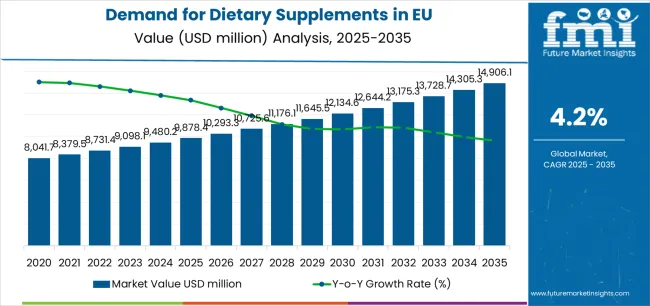
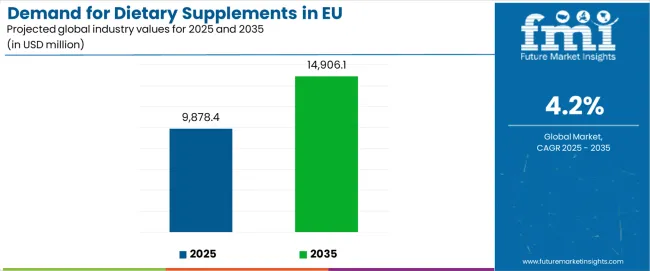
| Metric | Value |
|---|---|
| Market Value (2025) | USD 9,878.4 million |
| Market Forecast Value (2035) | USD 14906.1 million |
| Forecast CAGR (2025-2035) | 4.2% |
Between 2025 and 2030, EU dietary supplement demand is projected to expand from USD 9,878.4 million to USD 12,120.8 million, resulting in a value increase of USD 2,242.4 million, which represents 44.9% of the total forecast growth for the decade. This phase of development will be shaped by rising consumer adoption of preventive healthcare approaches, increasing availability of diverse product formats across tablets, capsules, gummies, and powders, and growing mainstream acceptance of dietary supplements as essential wellness tools across all demographic segments. Manufacturers are expanding their product portfolios to address evolving preferences for targeted health solutions, science-backed formulations, and premium ingredients comparable to pharmaceutical-grade quality standards.
From 2030 to 2035, sales are forecast to grow from USD 12,120.8 million to USD 14,873.3 million, adding another USD 2,752.5 million, which constitutes 55.1% of the overall ten-year expansion. This period is expected to be characterized by further expansion of personalized nutrition solutions, integration of advanced delivery systems for enhanced bioavailability, and development of condition-specific formulations targeting diverse health concerns. The growing emphasis on clean-label supplements and increasing consumer willingness to invest in premium wellness products will drive demand for high-quality dietary supplements that deliver clinically validated benefits with superior ingredient transparency.
Between 2020 and 2025, EU dietary supplement sales experienced steady expansion at a CAGR of 4.2%, growing from USD 8,050.6 million to USD 9,878.4 million. This period was driven by increasing health consciousness accelerated by global health concerns, rising awareness of immune system support, and growing recognition of nutritional gaps in modern diets. The industry developed as major pharmaceutical companies, specialized nutraceutical brands, and wellness-focused retailers recognized the commercial potential of preventive health solutions. Product innovations, improved bioavailability technologies, and evidence-based formulations began establishing consumer confidence and mainstream acceptance of dietary supplement products.
Industry expansion is being supported by the rapid demographic aging across European countries and the corresponding demand for age-related health management solutions with proven efficacy in maintaining wellness and preventing chronic conditions. Modern consumers rely on dietary supplements as essential components of daily health routines for immune system fortification, bone health maintenance, cardiovascular support, and cognitive function preservation, driving demand for products that deliver scientifically validated benefits, including targeted nutrient delivery, optimal absorption rates, and comprehensive health support. Even minor wellness considerations, such as seasonal immunity concerns, energy level management, or dietary nutrient gaps, can drive comprehensive adoption of dietary supplements to maintain optimal health and support quality of life.
The growing awareness of preventive healthcare and increasing recognition of dietary supplements' role in wellness management are driving demand for supplement products from certified manufacturers with appropriate quality credentials and transparent sourcing practices. Regulatory authorities are increasingly establishing stringent guidelines for dietary supplement manufacturing, labeling accuracy, and safety requirements to maintain consumer protection and ensure product quality. Scientific research studies and clinical trials are providing robust evidence supporting dietary supplements' health benefits and functional advantages, requiring specialized manufacturing processes and standardized quality protocols for ingredient purity verification, optimal potency maintenance, and appropriate safety profiles, including third-party testing and quality certifications.
Sales are segmented by product type (ingredients), application, distribution channel, nature, and country. By product type, demand is divided into vitamins & minerals, herbal supplements, proteins & amino acids, prebiotics & probiotics, and fatty acids. Based on application, sales are categorized into general wellness, immune health, digestive health, bone & joint, heart health, weight management, and sports nutrition. In terms of distribution channel, demand is segmented into pharmacies/drug stores, online (e-commerce/D2C), supermarkets/hypermarkets, specialty stores, and others. By nature, sales are classified into conventional and organic. Regionally, demand is focused on Germany, France, Italy, Spain, the Netherlands, and the Rest of Europe.
.webp)
The vitamins & minerals segment is projected to account for 33% of EU dietary supplement sales in 2025, declining slightly to 31% by 2035, establishing itself as the foundational category across European consumers seeking essential nutrient supplementation. This commanding position is fundamentally supported by vitamins & minerals' universal health importance, comprehensive scientific validation supporting deficiency prevention, and broad demographic appeal spanning all age groups from children to elderly populations. The vitamins & minerals format delivers exceptional mainstream accessibility, providing retailers with a product category that facilitates household penetration, supports preventive health positioning, and maintains consumer trust essential for category credibility.
This segment benefits from extensive clinical research, well-established pharmaceutical-grade manufacturing, and comprehensive variety from multiple brands who maintain rigorous quality standards and continuous formulation innovation. Vitamins & minerals supplements offer versatility across various health objectives, including immune system support, bone health maintenance, energy metabolism, and cognitive function, supported by decades of nutritional science validating essential nutrient roles in human physiology.
The vitamins & minerals segment is expected to maintain strong positioning at 31% share through 2035, demonstrating stable demand as specialized segments like herbal supplements and prebiotics/probiotics gain modest share through targeted health positioning throughout the forecast period.
Key advantages:
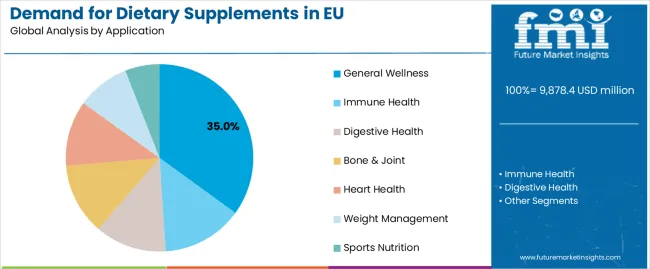
General wellness applications are positioned to represent 35% of total dietary supplement demand across European operations in 2025, declining slightly to 33% by 2035, reflecting the segment's dominance as the primary consumption driver within the overall category. This substantial share directly demonstrates that preventive health maintenance represents the core motivation, with consumers purchasing multivitamins, antioxidants, and broad-spectrum supplements for overall health optimization requiring comprehensive nutritional support.
Modern consumers increasingly view general wellness supplements as foundational daily health insurance, driving demand for products optimized for comprehensive nutrient coverage, appropriate dosing for daily maintenance, and balanced formulations that resonate across health-conscious populations seeking preventive approaches. The segment benefits from versatile positioning supporting multiple health objectives, established consumption routines integrated into daily wellness practices, and broad appeal transcending specific health conditions.
The segment's slight share decline reflects faster expansion in targeted applications like sports nutrition and digestive health, which accelerate as consumers increasingly seek specialized solutions beyond basic wellness support throughout the forecast period.
Key drivers:
Pharmacies and drug stores are strategically estimated to control 40% of total European dietary supplement sales in 2025, declining to 36% by 2035, reflecting traditional healthcare channels' established position while facing growing competition from digital platforms. European pharmacy operators consistently demonstrate strong credibility for dietary supplements that deliver professional guidance, quality assurance, and trusted recommendations across licensed healthcare environments.
The segment provides essential trust-building touchpoints through pharmacist consultations, professional product selection assistance, and healthcare-oriented merchandising strategies that optimize consumer confidence and informed purchasing. Major European pharmacy chains, including Boots, DocMorris, Lloyds Pharmacy, and independent pharmacies, systematically maintain comprehensive dietary supplement selections, often featuring pharmaceutical-grade brands and clinically validated products that normalize supplement usage as legitimate health interventions.
The segment's declining share reflects accelerating e-commerce adoption, with pharmacies maintaining absolute growth while online channels expand more rapidly throughout the forecast period.
Success factors:
Conventional dietary supplement products are strategically positioned to contribute 82% of total European sales in 2025, declining to 76% by 2035, representing products produced through standard manufacturing without organic certification requirements. These conventional products successfully deliver accessible pricing and consistent quality while ensuring broad commercial availability across all distribution channels that prioritize volume scalability and cost competitiveness over organic certification.
Conventional production serves price-conscious consumers, mainstream wellness applications, and value-oriented buyers that require affordable nutritional supplementation at competitive price points. The segment derives significant competitive advantages from established ingredient supply chains, economies of scale in manufacturing, and the ability to meet substantial volume requirements from major retailers without organic certification constraints limiting ingredient sourcing options.
The segment's declining share through 2035 reflects the category's evolution toward premium organic products, which grow from 18% in 2025 to 24% in 2035, as health-conscious consumers increasingly prioritize organic certification and natural sourcing practices.
Competitive advantages:
EU dietary supplement sales are advancing steadily due to increasing aging population seeking preventive healthcare, growing health consciousness accelerated by wellness trends, and rising consumer awareness of nutritional deficiencies. However, the industry faces challenges, including regulatory complexity across different European markets, skepticism regarding efficacy claims for certain product categories, and competitive pressure from fortified functional foods addressing similar health objectives. Continued innovation in bioavailability enhancement and clinical validation remains central to industry development.
The rapidly accelerating development of personalized nutrition technologies is fundamentally transforming dietary supplements from one-size-fits-all products to targeted solutions, enabling customized formulations addressing individual health profiles, genetic predispositions, and specific wellness objectives previously unavailable through standard multivitamin approaches. Advanced personalization platforms featuring DNA testing, blood biomarker analysis, and lifestyle assessment algorithms allow manufacturers to recommend dietary supplements with precise nutrient combinations, individualized dosing, and condition-specific targeting comparable to pharmaceutical precision. These personalization innovations prove particularly transformative for health-conscious consumers, including biohackers, longevity enthusiasts, and chronic condition management seekers, where customized formulations prove essential for optimal health outcomes.
Major dietary supplement brands invest heavily in digital health partnerships, personalization technology development, and direct-to-consumer platforms supporting customized recommendations, recognizing that personalized nutrition represents breakthrough solutions for generic positioning challenges limiting premium segment expansion. Manufacturers collaborate with testing laboratories, health technology companies, and medical professionals to develop scalable personalization systems that deliver individualized supplement regimens while maintaining manufacturing feasibility supporting commercial viability.
Modern dietary supplement producers systematically incorporate advanced delivery technologies, including liposomal encapsulation, microencapsulation, and nano-emulsion systems that deliver superior nutrient absorption, enhanced bioavailability, and optimized therapeutic effectiveness comparable to pharmaceutical delivery mechanisms. Strategic integration of bioavailability technologies optimized for nutrient delivery enables manufacturers to position dietary supplements as clinically effective products where absorption efficiency directly determines health-conscious consumer purchasing behavior. These technological improvements prove essential for premium positioning, as efficacy-focused consumers demand bioavailability verification, clinical evidence supporting enhanced absorption, and measurable health benefits.
Companies implement extensive bioavailability research programs, delivery technology partnerships with pharmaceutical ingredient suppliers, and clinical testing validating absorption enhancement, including pharmacokinetic studies, comparative bioavailability trials, and efficacy validation throughout product development. Manufacturers leverage advanced delivery positioning in marketing communications, on-pack claims featuring bioavailability advantages, and premium pricing justification, positioning technologically enhanced supplements as superior alternatives delivering measurable benefits.
European consumers and fitness enthusiasts increasingly prioritize sports nutrition supplements featuring protein powders, amino acid complexes, and performance-enhancing formulations that differentiate athletic products through recovery support and performance optimization. This sports nutrition trend enables manufacturers to drive premium pricing through specialized positioning, performance benefit communication, and brand differentiation resonating with active consumers seeking competitive advantages. Sports nutrition innovation proves particularly important for younger demographics where fitness culture drives supplement adoption and social influence.
The development of sophisticated sports nutrition formulations, including plant-based proteins, pre-workout complexes, and recovery optimization blends expands manufacturers' abilities to create performance-focused products delivering athletic benefits without pharmaceutical interventions. Brands collaborate with sports scientists, professional athletes, and fitness influencers to develop formulations balancing efficacy with safety, supporting premium pricing and brand loyalty while maintaining clean-label credentials across health-conscious athletic segments.
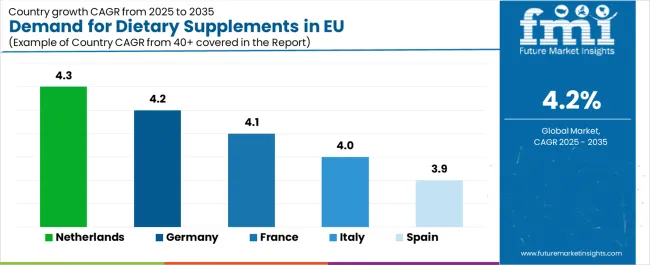
| Country | CAGR % (2025-2035) |
|---|---|
| Netherlands | 4.3% |
| Germany | 4.2% |
| France | 4.1% |
| Italy | 4% |
| Spain | 3.9% |
EU dietary supplement sales are projected to grow steadily from 2025 to 2035, with Rest of Europe leading expansion at 12.1% CAGR, supported by developing markets and rising wellness adoption. The Netherlands follows at 4.3% CAGR, reflecting strong health consciousness and receptivity to innovation. Among the larger economies, Germany (4.2%), France (4.1%), Italy (4%), and Spain (3.9%) demonstrate consistent mid-range growth, underpinned by established healthcare cultures, aging demographics, and sustained consumer demand for preventive health solutions. Overall, the region reflects robust and diversified growth momentum across both mature and emerging markets.
Revenue from dietary supplements in Germany is projected to exhibit steady growth with a CAGR of 4.2% through 2035, driven by exceptionally large population base, well-developed health consciousness, and strong cultural emphasis on preventive wellness throughout the country. Germany's sophisticated healthcare system and internationally recognized leadership in pharmaceutical quality standards are creating substantial demand for diverse dietary supplement varieties across all consumer segments.
Major pharmacy chains, including DocMorris, Zur Rose, and independent apotheken, systematically maintain extensive dietary supplement selections, often dedicating substantial retail space to vitamins, minerals, and specialized wellness products to serve health-conscious consumers. German demand benefits from high trust in pharmacy-grade supplements, substantial healthcare spending supporting premium products, and cultural preference for quality-certified supplements that naturally supports premium positioning across mainstream consumers beyond budget-focused purchasing.
Growth drivers:
Revenue from dietary supplements in France is expanding at a CAGR of 4.1%, supported by strong pharmacy tradition, growing wellness awareness, and increasing consumer acceptance of nutritional supplementation. France's sophisticated healthcare system and pharmacy-centric distribution model are driving demand for quality dietary supplements across therapeutic and wellness applications.
Major pharmacy chains, including Pharmacie Lafayette, Pharmacie Monge, and parapharmacy retailers, systematically expand dietary supplement offerings to address growing wellness demand. French sales particularly benefit from healthcare professional recommendations, creating natural adoption through trusted guidance, combined with increasing awareness of nutritional deficiencies contributing to expansion through preventive health positioning.
Success factors:
Revenue from dietary supplements in Italy is growing at a steady CAGR of 4%, fundamentally driven by aging population, growing health consciousness, and Mediterranean wellness culture increasingly incorporating targeted supplementation. Italy's traditional focus on health and longevity is supporting dietary supplement adoption as complementary approaches to healthy lifestyle practices.
Major pharmacy chains and health retailers, including farmacia networks, parapharmacies, and specialized wellness stores, strategically invest in dietary supplement category expansion addressing growing health awareness. Italian sales particularly benefit from aging demographics requiring bone health, cardiovascular support, and cognitive function maintenance, creating natural adoption among senior populations.
Development factors:
Demand for dietary supplements in Spain is projected to grow at a CAGR of 3.9%, supported by growing health consciousness, expanding pharmacy infrastructure, and increasing consumer awareness of nutritional supplementation benefits. Spanish consumer interest in wellness and active aging positions dietary supplements as aligned with health optimization objectives.
Major pharmacy chains and retailers, including Farmacias del Ahorro, Cruz Verde, and supermarket pharmacy sections, systematically expand dietary supplement offerings to serve growing demand. Spain's developing wellness culture supports supplement trial among health-conscious consumers seeking proactive health management solutions.
Growth enablers:
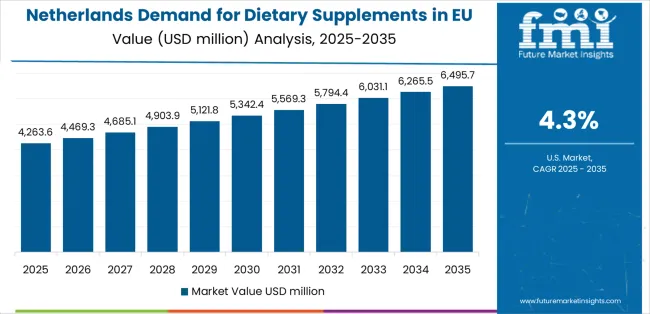
Demand for dietary supplements in the Netherlands is expanding at a leading CAGR of 4.3%, fundamentally driven by exceptionally strong health consciousness, progressive wellness culture, and comprehensive retail support for premium supplements across Dutch channels. Dutch consumers demonstrate particularly high receptivity to innovative supplement solutions and willingness to invest in quality products.
Netherlands sales significantly benefit from sophisticated retail infrastructure, including Kruidvat's extensive supplement sections, Etos' wellness focus, and innovative direct-to-consumer brands testing new products in a receptive Dutch environment. The country's progressive health culture positions Netherlands as innovation testing ground for European supplement categories.
Innovation drivers:
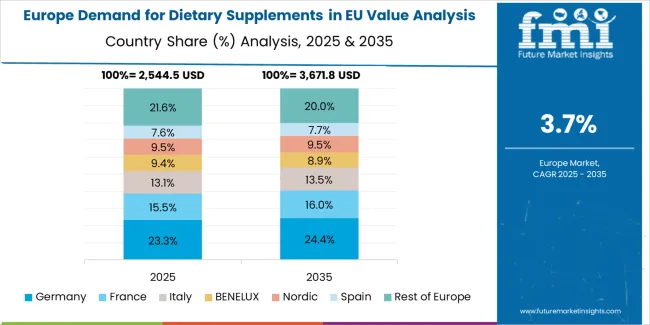
EU dietary supplement sales are projected to grow from USD 9,878.4 million in 2025 to USD 14,873.3 million by 2035, registering a CAGR of 4.2% over the forecast period. Rest of Europe is expected to demonstrate the strongest growth trajectory with a 12.1% CAGR, supported by developing wellness cultures, increasing healthcare infrastructure, and rising disposable incomes. Netherlands follows with 4.3% CAGR, attributed to progressive health consciousness and advanced retail sophistication.
Germany maintains the largest share at 34.3% in 2025, driven by established health awareness, strong pharmacy infrastructure, and quality-focused consumer base, while growing at 4.2% CAGR. France, Italy, and Spain all demonstrate 4.2% CAGR, reflecting consistent market development across major European economies.
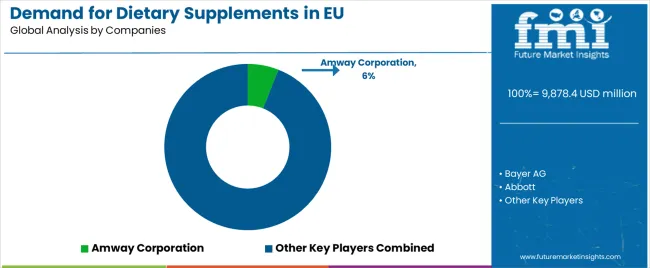
EU dietary supplement sales are defined by competition among direct selling companies, pharmaceutical corporations, specialized nutraceutical brands, and emerging wellness startups. Companies are investing in clinical validation studies, personalized nutrition platforms, bioavailability enhancement technologies, and clean-label formulation development to deliver high-quality, scientifically validated, and consumer-trusted dietary supplement solutions. Strategic partnerships with healthcare professionals, digital health technology integration, and marketing campaigns emphasizing clinical evidence and quality certifications are central to strengthening competitive position.
Major participants include Amway Corporation with an estimated 6% share, leveraging its direct selling expertise, comprehensive product portfolio, and established European presence through independent distributor networks. Amway benefits from personal relationship selling, multi-level marketing capabilities, and ability to provide personalized recommendations through direct contact, supporting premium positioning and brand loyalty.
Bayer AG holds approximately 5% share, emphasizing pharmaceutical quality standards, clinical validation expertise, and consumer trust earned through healthcare heritage. Bayer's success in applying pharmaceutical-grade manufacturing to dietary supplements creates strong quality positioning and professional endorsement, supported by scientific credibility and established brand reputation.
Abbott accounts for roughly 4% share through its position as healthcare nutrition leader with clinical expertise, providing medically positioned dietary supplements through evidence-based formulation. The company benefits from healthcare professional relationships, clinical nutrition specialization, and comprehensive quality assurance supporting therapeutic positioning and medical channel distribution.
Glanbia plc represents approximately 3% share, supporting growth through sports nutrition leadership, protein specialization, and performance-oriented product development. Glanbia leverages athletic positioning for sports supplement market dominance, innovation capabilities, and brand building expertise, attracting fitness enthusiasts seeking performance optimization.
Other companies collectively hold 82% share, reflecting highly fragmented competitive dynamics within European dietary supplement sales, where numerous specialized brands, private-label suppliers for major retailers, regional manufacturers, and emerging direct-to-consumer startups serve specific health conditions, demographic segments, and niche applications. This competitive environment provides opportunities for differentiation through specialized formulations (vegan, allergen-free), innovative delivery systems (gummies, effervescent), unique ingredient sourcing, and premium positioning resonating with health-conscious consumers seeking targeted wellness solutions.
| Item | Value |
|---|---|
| Quantitative Units | USD 14906.1 million |
| Product Type (Ingredients) | Vitamins & Minerals, Herbal Supplements, Proteins & Amino Acids, Prebiotics & Probiotics, Fatty Acids |
| Application | General Wellness, Immune Health, Digestive Health, Bone & Joint, Heart Health, Weight Management, Sports Nutrition |
| Distribution Channel | Pharmacies/Drug Stores, Online (E-commerce/D2C), Supermarkets/Hypermarkets, Specialty Stores, Others |
| Nature | Conventional, Organic |
| Countries Covered | Germany, France, Italy, Spain, the Netherlands, and the Rest of Europe |
| Key Companies Profiled | Amway, Bayer, Abbott, Glanbia, Specialized nutraceutical brands |
| Additional Attributes | Dollar sales by product type (ingredients), application, distribution channel, and nature; regional demand trends across major European economies; competitive landscape analysis with pharmaceutical companies, direct selling firms, and specialized wellness brands; consumer preferences for various supplement formats and health applications; integration with personalized nutrition technologies and bioavailability enhancement systems; innovations in targeted formulations and clinical validation; adoption across preventive healthcare, therapeutic support, and performance optimization applications; regulatory framework analysis for dietary supplement manufacturing and health claims; supply chain strategies; and penetration analysis for mainstream and health-conscious European consumers. |
The global demand for dietary supplements in EU is estimated to be valued at USD 9,878.4 million in 2025.
The market size for the demand for dietary supplements in EU is projected to reach USD 14,906.1 million by 2035.
The demand for dietary supplements in EU is expected to grow at a 4.2% CAGR between 2025 and 2035.
The key product types in demand for dietary supplements in EU are vitamins & minerals, herbal supplements, proteins & amino acids, prebiotics & probiotics and fatty acids.
In terms of application, general wellness segment to command 35.0% share in the demand for dietary supplements in EU in 2025.






Our Research Products

The "Full Research Suite" delivers actionable market intel, deep dives on markets or technologies, so clients act faster, cut risk, and unlock growth.

The Leaderboard benchmarks and ranks top vendors, classifying them as Established Leaders, Leading Challengers, or Disruptors & Challengers.

Locates where complements amplify value and substitutes erode it, forecasting net impact by horizon

We deliver granular, decision-grade intel: market sizing, 5-year forecasts, pricing, adoption, usage, revenue, and operational KPIs—plus competitor tracking, regulation, and value chains—across 60 countries broadly.

Spot the shifts before they hit your P&L. We track inflection points, adoption curves, pricing moves, and ecosystem plays to show where demand is heading, why it is changing, and what to do next across high-growth markets and disruptive tech

Real-time reads of user behavior. We track shifting priorities, perceptions of today’s and next-gen services, and provider experience, then pace how fast tech moves from trial to adoption, blending buyer, consumer, and channel inputs with social signals (#WhySwitch, #UX).

Partner with our analyst team to build a custom report designed around your business priorities. From analysing market trends to assessing competitors or crafting bespoke datasets, we tailor insights to your needs.
Supplier Intelligence
Discovery & Profiling
Capacity & Footprint
Performance & Risk
Compliance & Governance
Commercial Readiness
Who Supplies Whom
Scorecards & Shortlists
Playbooks & Docs
Category Intelligence
Definition & Scope
Demand & Use Cases
Cost Drivers
Market Structure
Supply Chain Map
Trade & Policy
Operating Norms
Deliverables
Buyer Intelligence
Account Basics
Spend & Scope
Procurement Model
Vendor Requirements
Terms & Policies
Entry Strategy
Pain Points & Triggers
Outputs
Pricing Analysis
Benchmarks
Trends
Should-Cost
Indexation
Landed Cost
Commercial Terms
Deliverables
Brand Analysis
Positioning & Value Prop
Share & Presence
Customer Evidence
Go-to-Market
Digital & Reputation
Compliance & Trust
KPIs & Gaps
Outputs
Full Research Suite comprises of:
Market outlook & trends analysis
Interviews & case studies
Strategic recommendations
Vendor profiles & capabilities analysis
5-year forecasts
8 regions and 60+ country-level data splits
Market segment data splits
12 months of continuous data updates
DELIVERED AS:
PDF EXCEL ONLINE
Western Europe Dietary Supplements Market Analysis by Ingredients, Form, Application, and Country Through 2025 to 2035
Dietary Supplements Packaging Market Analysis – Trends & Forecast 2025-2035
Europe Pet Dietary Supplement Market Trends – Growth, Demand & Outlook 2025-2035
EU Longevity Supplements Sales Analysis Size and Share Forecast Outlook 2025 to 2035
Comprehensive Analysis of Europe Pet Food Supplements Market by Nature, Form, Pet Type and Distribution Channel through 2035
Japan Dietary Supplements Market, By Ingredients, Form, Application, and Region through 2035
Korea Dietary Supplements Market Analysis by Ingredients, Form, Application, and Region Through 2035
Veterinary Dietary Supplements Market Size and Share Forecast Outlook 2025 to 2035
North American Dietary Supplements Market Size and Share Forecast Outlook 2025 to 2035
Demand for Calcium Supplements in EU Size and Share Forecast Outlook 2025 to 2035
Demand for Fertility Supplements in EU Size and Share Forecast Outlook 2025 to 2035
Demand for Probiotic Supplements in EU Size and Share Forecast Outlook 2025 to 2035
Demand for Postbiotic Supplements in EU Size and Share Forecast Outlook 2025 to 2035
Demand for Postnatal Health Supplements in EU Size and Share Forecast Outlook 2025 to 2035
Europe Radiotherapy Patient Positioning Market Size and Share Forecast Outlook 2025 to 2035
Europe Polyvinyl Alcohol Industry Analysis Size and Share Forecast Outlook 2025 to 2035
Europe Cruise Market Forecast and Outlook 2025 to 2035
Europium Market Forecast and Outlook 2025 to 2035
Eucommia Leaf Extract Market Size and Share Forecast Outlook 2025 to 2035
Europe Massage Therapy Service Market Size and Share Forecast Outlook 2025 to 2035

Thank you!
You will receive an email from our Business Development Manager. Please be sure to check your SPAM/JUNK folder too.
Chat With
MaRIA